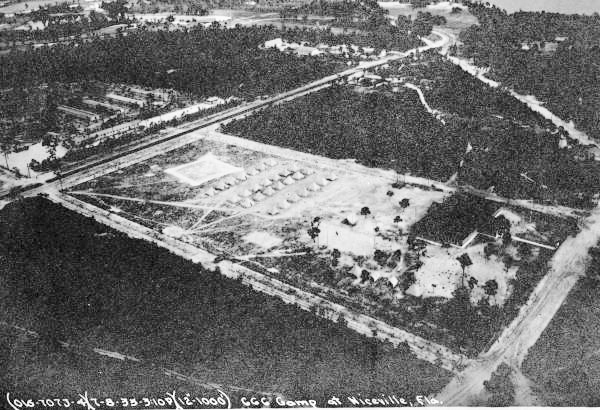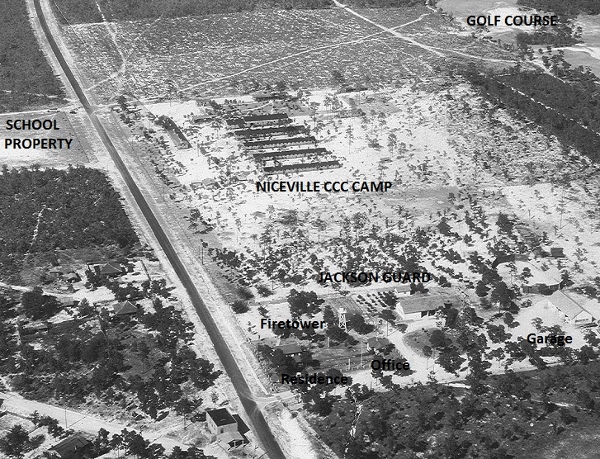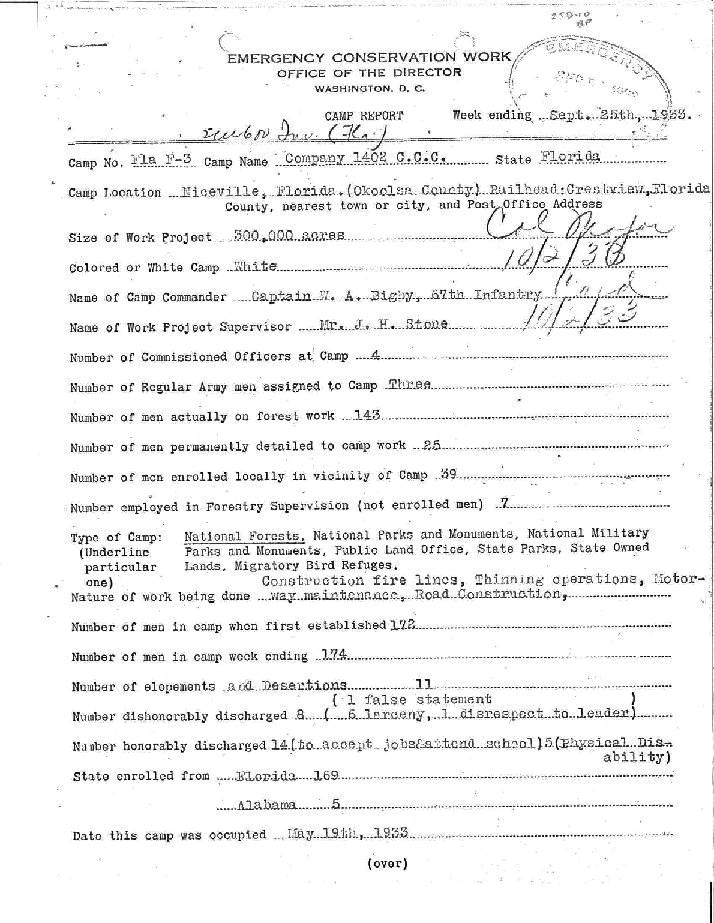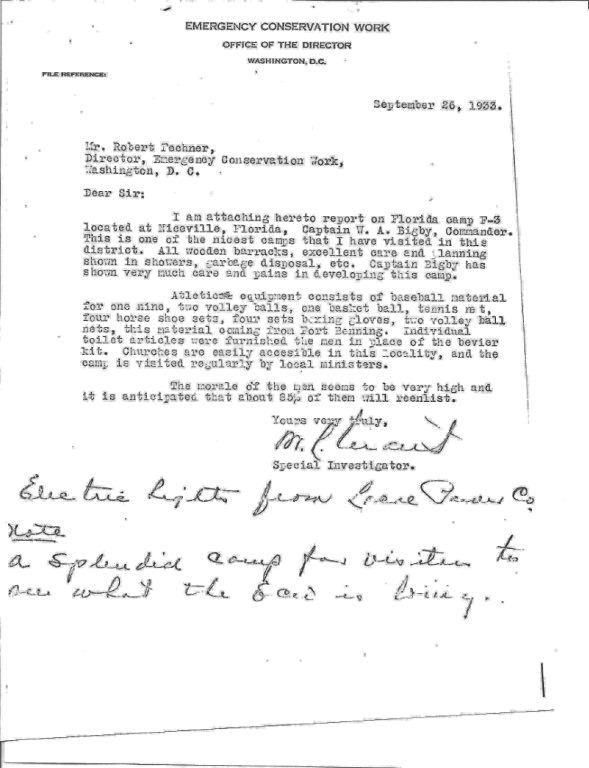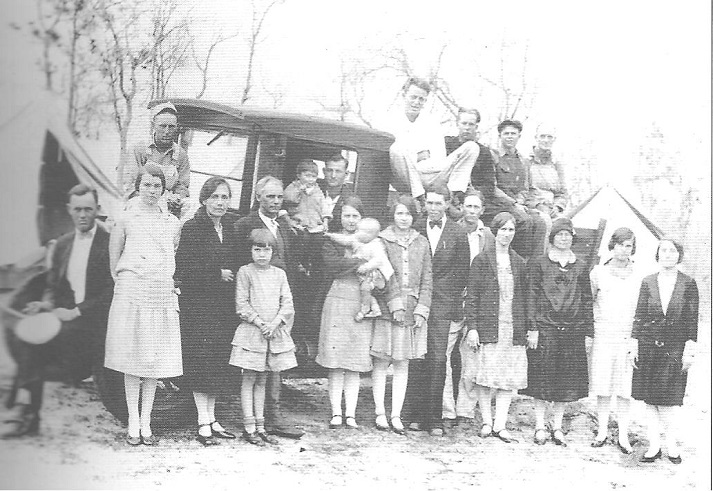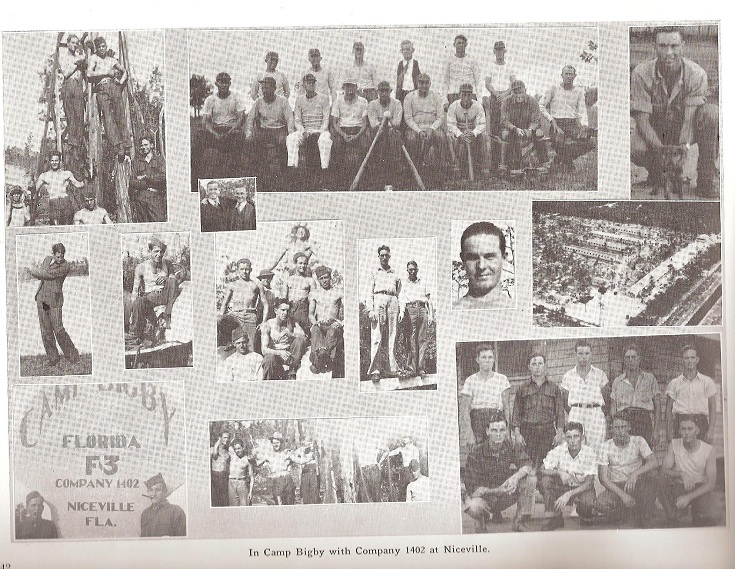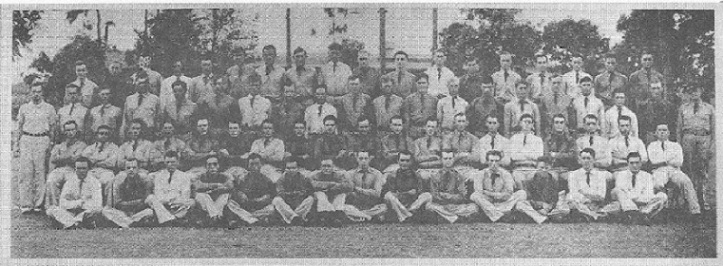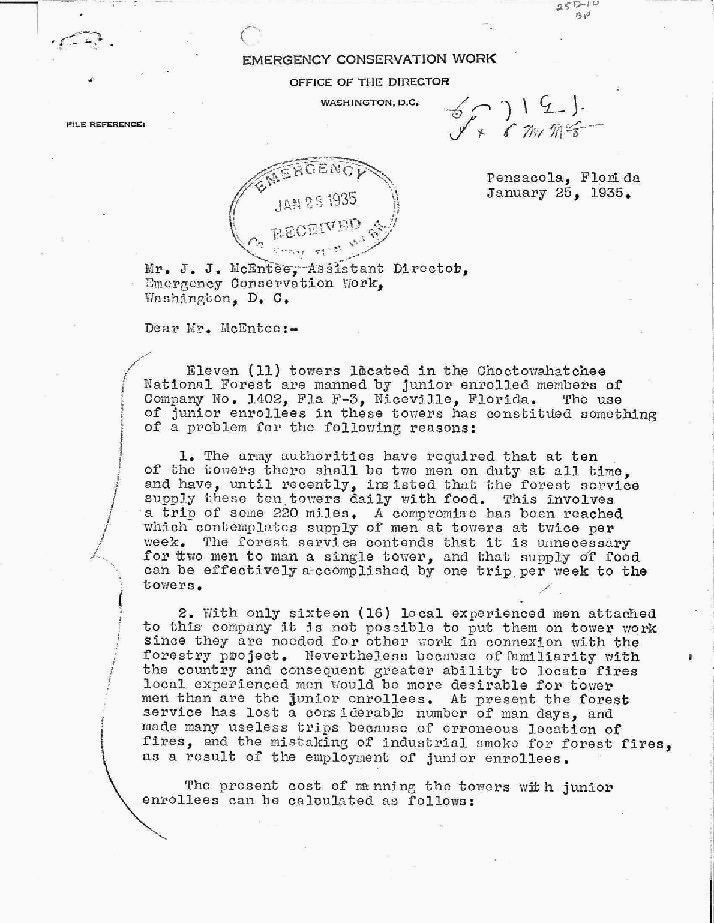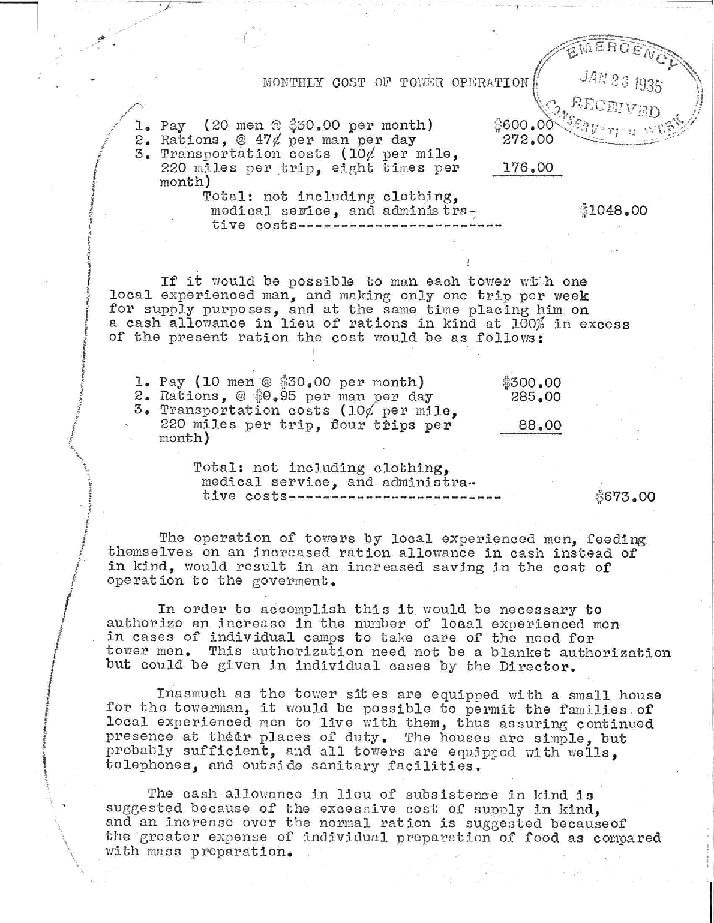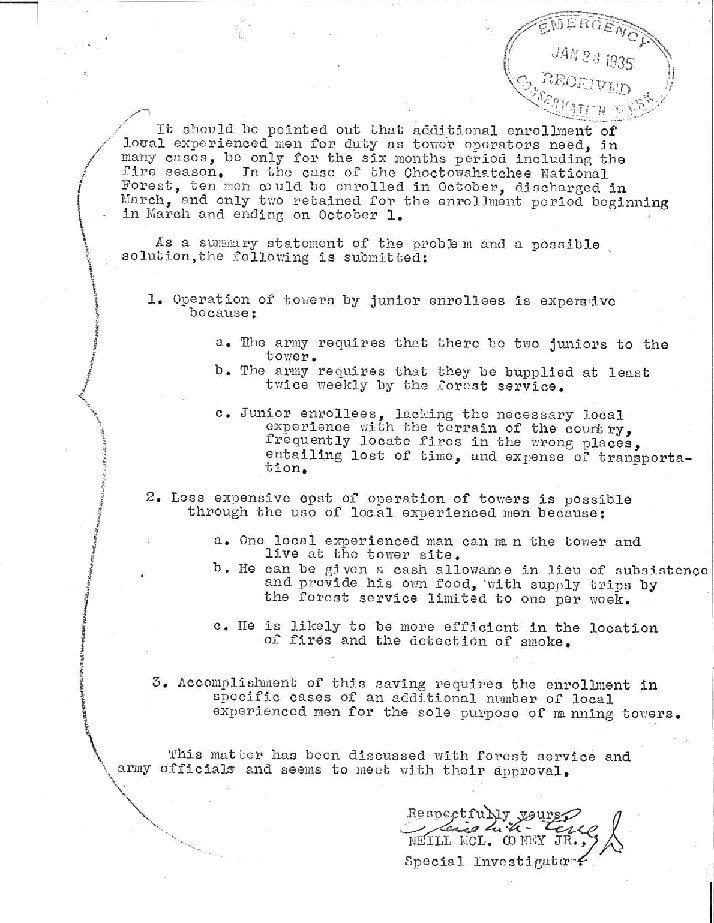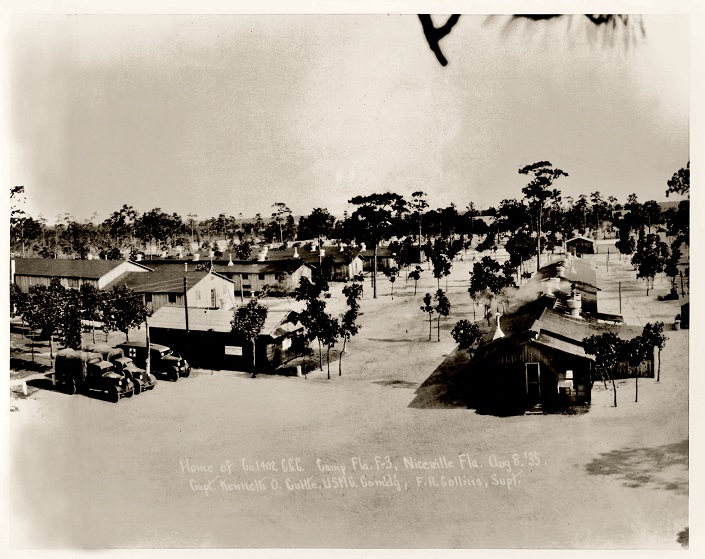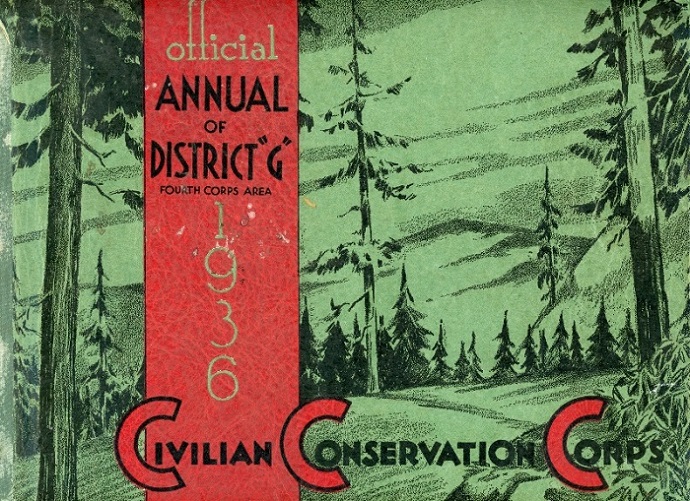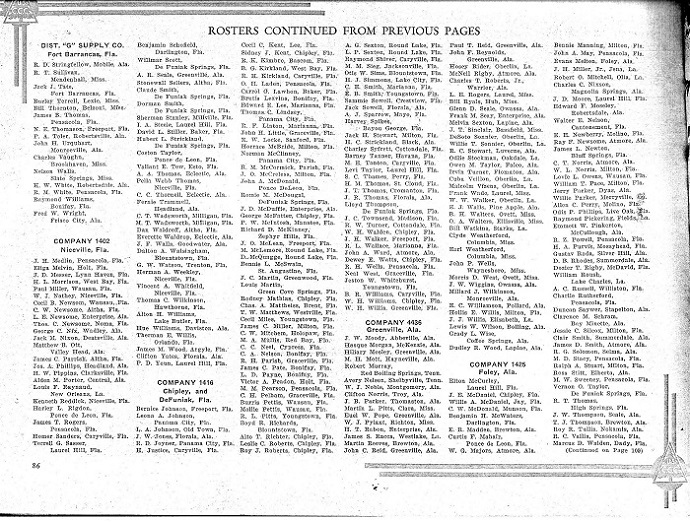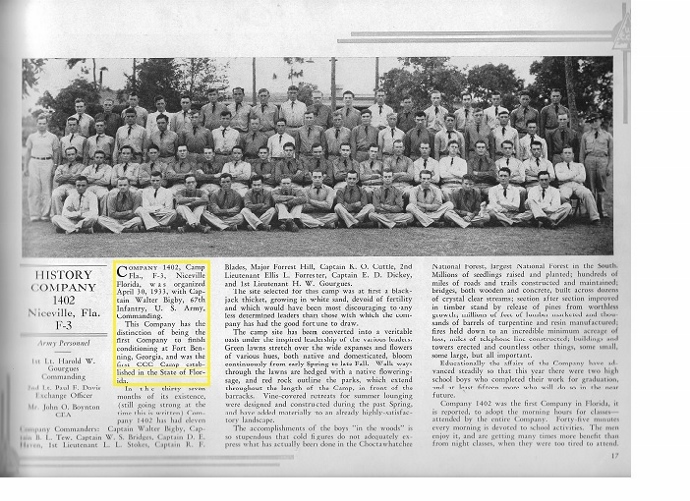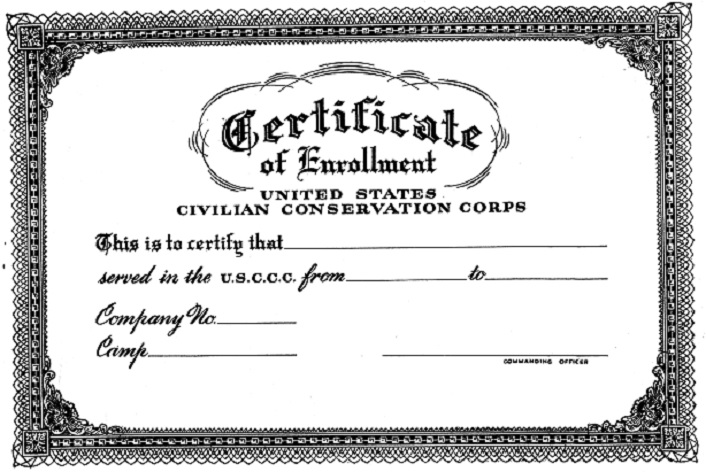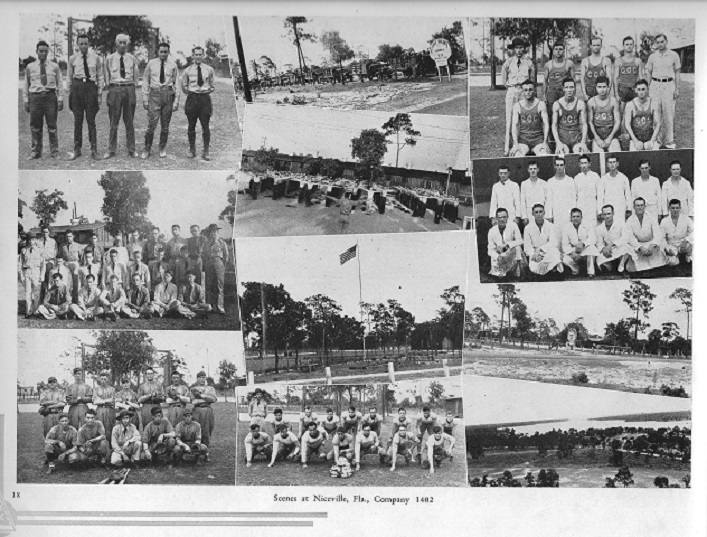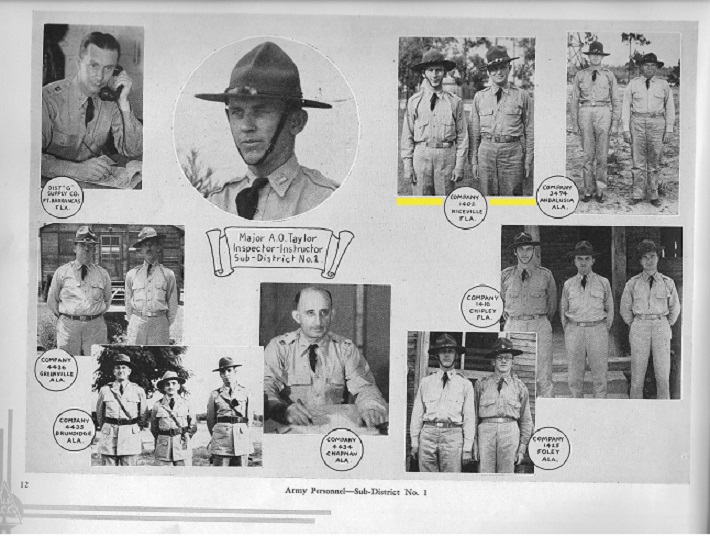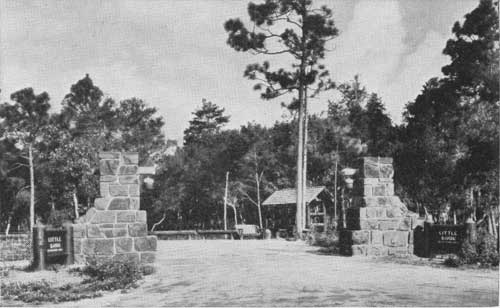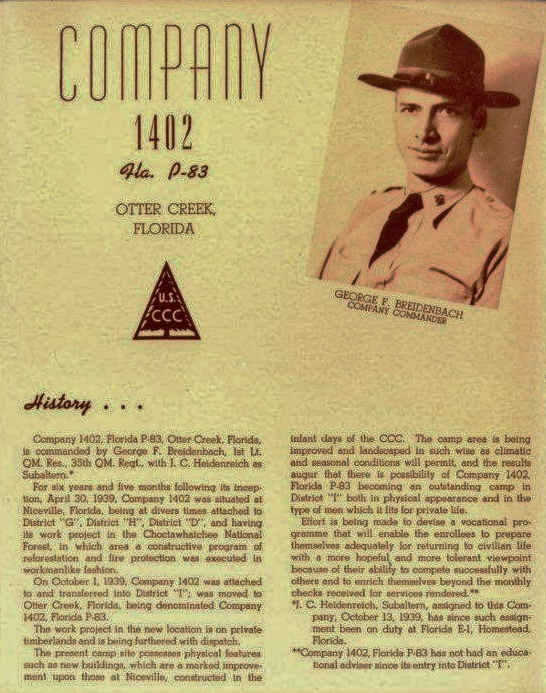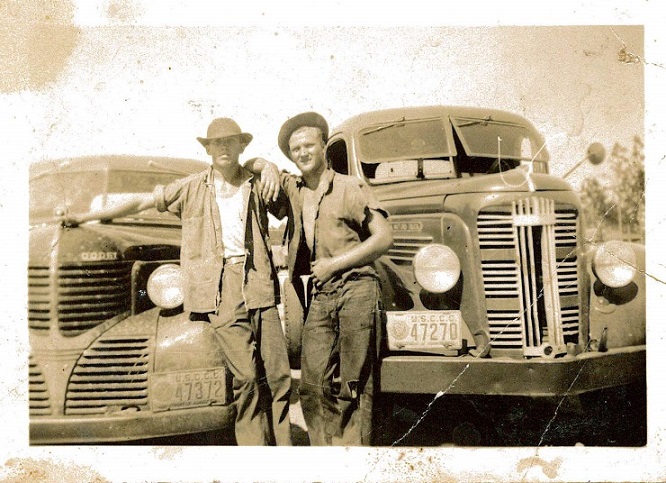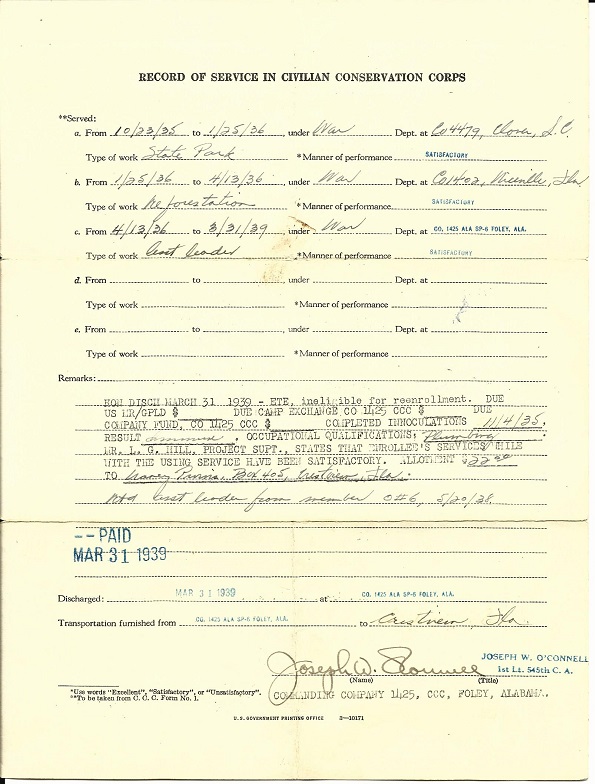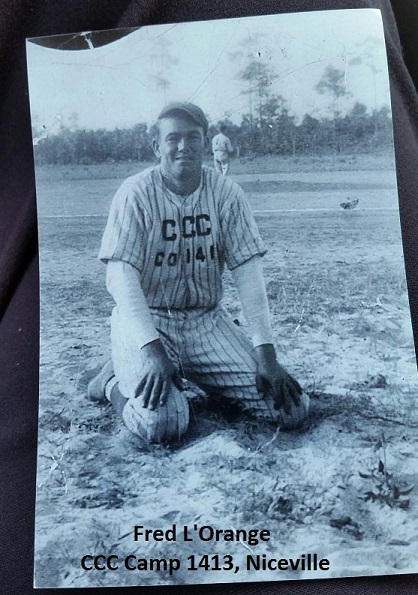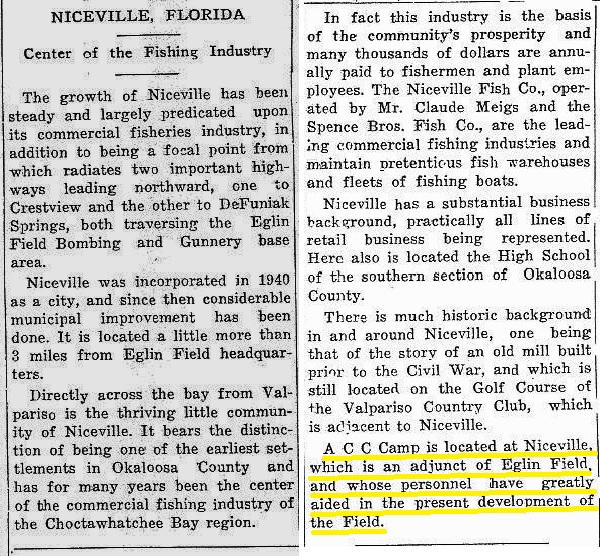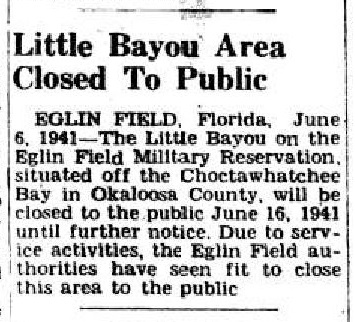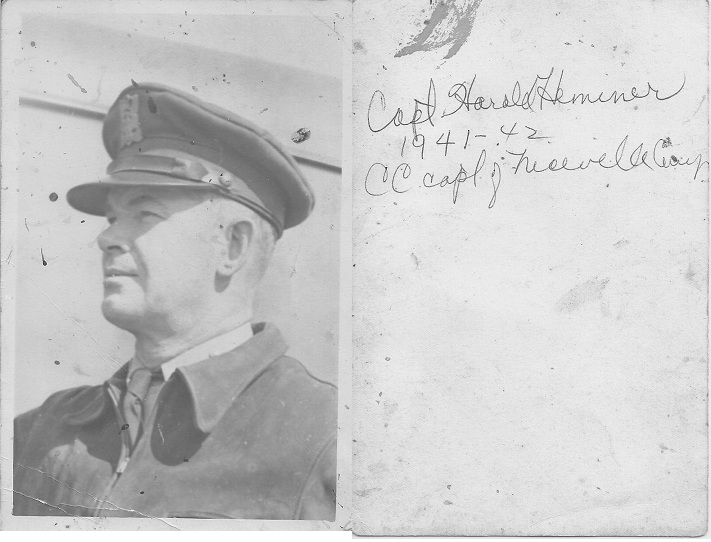1402 Forest-3 (1933-39), 1413 Army-1 (1940-42)
(A section of the NICEVILLE, FLORIDA - Online History Center)
"This generation of Americans has a
rendezvous with destiny."
~ Franklin D. Roosevelt, U.S. President
1933-1945
Dedication CCC Worker Statue #77 Niceville
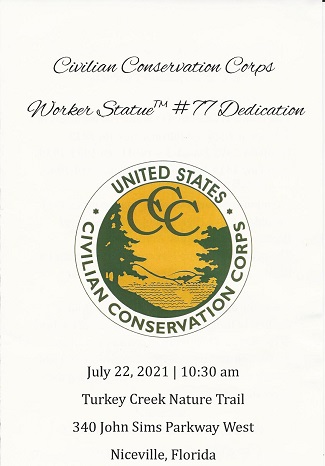
The District G CCC Annuals and Niceville camp newsletters have been instrumental in telling the story of Camp Bigby. The newsletter names changed from time to time. The Boggy Bayou Breeze, Scrappy Daze (a parody for the national newsletter, Happy Days) and Camp Bigby News were some. In 1937 the Journalism class under the direction of the Educational Adviser took over the local newspaper, The Valpariso (sic) News that was going out of business.
To honor Camp Bigby it is fitting that Niceville now has a CCC Worker Statue. It was procured through CCC Legacy in Edinburg, Virginia. This organization represents the CCC alumni of America and strives to bring awareness to the heritage of the CCC. Funding was provided by the City of Niceville and a few CCC advocates.
Niceville Worker Statue #77 was fabricated at an art gallery in Michigan. It is the first statue to have the CCC Legacy Logo. It is on the blade of the axe.
History gives communities identity and continuity, a sense of place and helps us to understand how the society we live in came to be. The Niceville statue presents a bold statement as Niceville claims its rightful place as an important heritage tourism destination. Statue #77 is a tangible reminder of our city history. It is now on 'the trail' along with 76 other CCC worker statues that have been dedicated throughout the nation.
 |
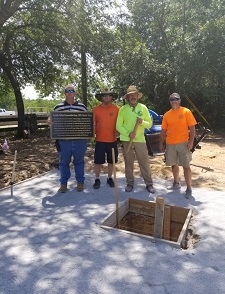 |
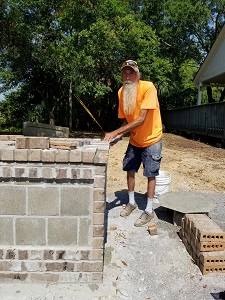 |
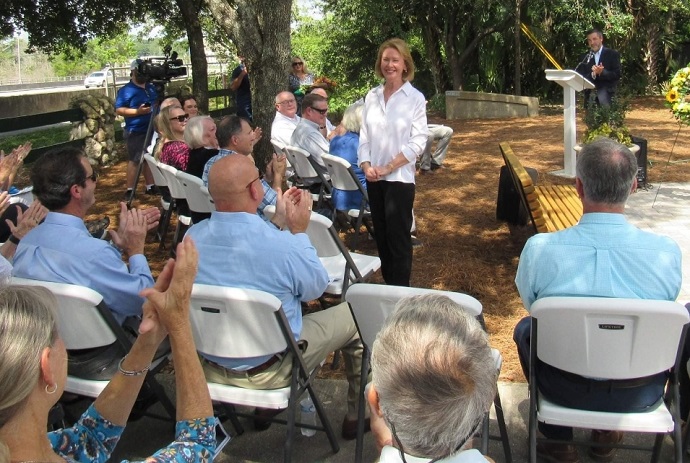
 |
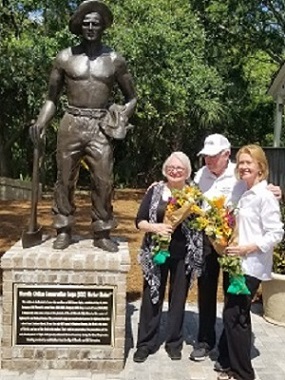 |
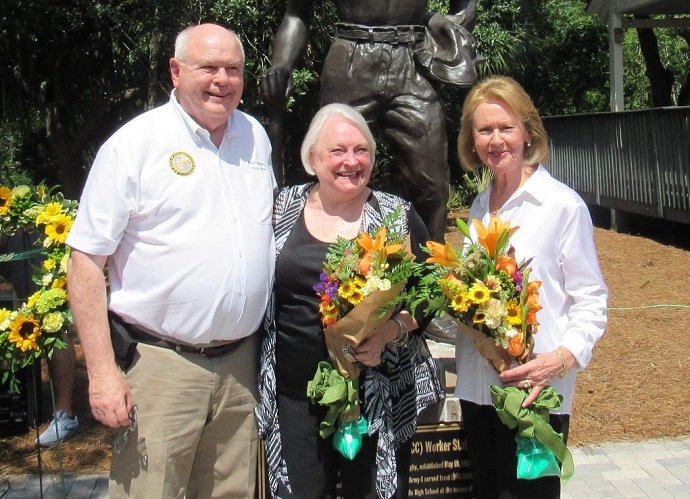
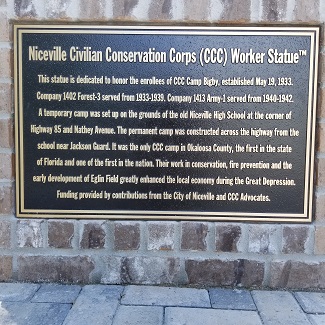 |
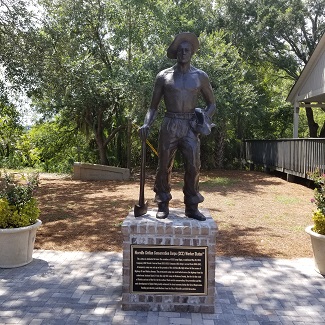 |
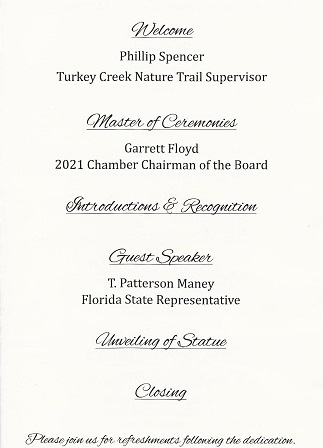 |
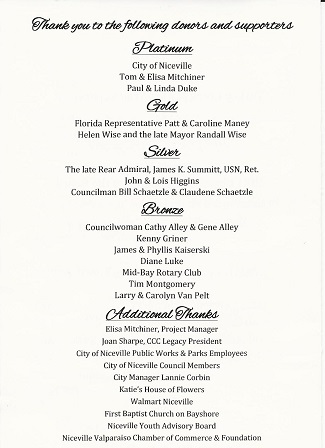 |
About the Civilian Conservation Corps (CCC)
To honor the veterans of WWII is to honor
Americans from all walks of life, backgrounds, experiences and locations. Their
stories tell the story of America. The soldier has a common image; and yet,
there is a segment of WWII veterans that were inducted into the rigid military
environment already armed with experiences that would put them ahead of the
game. That experience was the Civilian Conservation Corps.
The four presidential terms of
Franklin D. Roosevelt were plagued with one national crisis after another. As he
readied himself for his first term, America was in the grip of the Great
Depression, unemployment was reaching 25%, and socialist factions were gaining
popularity. Amid the social and economic unrest, the American public was
becoming disgruntled about their prospects for the future. In 1932 as FDR's
campaign song, "Happy Days are Here Again", sang out across the nation the hope
of citizens was lifted to new heights and he was elected in a landslide victory
over Herbert Hoover.
Inaugurated on March 4, 1933,
America's 32nd Commander and Chief was taking the helm of a troubled
land. Unemployment ravaged the ranks of the old, the handicapped, the uneducated
and the young. Available jobs went to the breadwinner and in many cases those
wages were not adequate to support the family. President Roosevelt was aware
that he needed to get people back to work.
Roosevelt acted quickly. On March
21, the President sent a message to the 73rd congress: "I propose to
create a civilian conservation corps to be used in simple work, not interfering
with normal employment, and confining itself to forestry, the prevention of soil
erosion, flood control and similar projects. More important, however, than
material gains, will be the moral and spiritual value of such work."
For ten days, Congress worked diligently and
on March 31, 1933 the Emergency Conservation Work legislation was signed. It
became commonly referred to as the Civilian Conservation Corps. On April 5,
Robert Fechner, an organized labor leader, was named by executive order as the
Executive Director. The President named the Secretaries of War, Agriculture,
Interior, and Labor as his advisory council. Determined to save America's youth from the
"moral dry rot" that accompanied excessive unemployment he set about to save two
of the nation's most valuable nature resources: men and land.
The plan was straight forward: The
War Department would transport, feed, clothe, shelter, educate and provide
health services. The Department of Agriculture and Interior developed natural
resource improvement projects. The Department of Labor identified those on
relief and the unemployed.
The War Department was the only
entity with the infrastructure to provide logistics for such a large body of men
and the transport of enrollees amounted to the largest peace-time movement of
people recorded in America to that date. Eventually, this plan placed the
responsibility of millions of young men within the care of the military system.
April 7, 1933 marked the first day of
recruitment for the young enrollees of Roosevelt's Tree Army
and Henry Rich from Alexandria ,VA, became recognized as America's first CCC
Enrollee. On April 17, Rich was among the first contingent of CCC enrollees to
slog through the mud into an open clearing in the George Washington National
Forest. The nation's first CCC camp, Camp Roosevelt NF-1 was established.
CCC camps were manned with
approximately 200 people that included enrollees, military leadership and the
conservation project staff. The enrollee requirements were simple: unemployed,
unmarried, healthy and between the ages of 17 - 25. Their youthful appearance
soon gave way to the nickname of "CCC Boys" which is still commonly used today.
The CCC development plan called for 250,000
men to be enrolled by July 1933. The military logistics system made this
possible and was the nucleus of the CCC program. After WW I, the military
recognized a need to segment the nation into the nine corps of the Army. Each
corps was commanded by a General officer and the CCC fell into alignment with
this military structure. From the General Officer at the corps level to the Camp
Commander, the military was in charge except during the eight hour work day
which was spent on natural resource conservation projects.
As the program
matured, the resemblance of the military lifestyle developed a cadre of men who
were accustomed to the multicultural communal living arrangements that mimicked
the military environment. From the very beginning, CCC boys began and ended
their day with reveille and retreat, slept in military tents or barracks, wore
WWI surplus military clothing, ate in the mess hall, and the military maintained
all records and pay responsibilities. The daily routine associated with personal
hygiene, laundry, inspections, and other types of self improvement was a change
for many unaccustomed to indoor plumbing and the discipline necessary for
positive personal deportment. The Camp Commander was the highest authority.
Many camp duties reflected the military
procedure. The company clerk who worked for the Camp Commander kept the camp
records and was accustomed to official forms and process. The cooks who worked
under the Mess Sergeant became familiar with the military culinary procedure for
preparation, food safety, ordering and storage. Records indicate that 45,000
truck drivers were trained annually. Knowing how to drive a truck safely, the
motor pool system, truck maintenance and mechanics, was a favorite position
within the camp but also provided a skill to the CCC enrollee as he moved into
the private sector or into the military.
Leader positions
in the CCC were many times compared to the rank of Sergeant and the CCC employee
could move laterally into the military system. Generally speaking, CCC enrollees
achieved rank earlier and many made permanent careers in the military or the
conservation agencies. These opportunities might never have come to pass without
the stint in the CCC.
Regular and reserve Officers of
all branches of service were pulled into the CCC program. The CCC leadership
role developed practical experiences which the reserve officer normally would
not have received during peace-time. Many highly decorated military leaders of WWII were CCC Camp
Commanders. Second Lieutenant William Train who was present at Camp Roosevelt on
April 17, 1933 finished his military career as Lieutenant General Train. Records
indicate that there were mixed feelings among some reserve officers about
serving on active duty in a CCC Camp. After all, the CCC enrollees were not
soldiers and the pomp and circumstance associated with the officer corps was not
available in remote rural communities.
As America
anxiously watched the war in Europe escalate, President Roosevelt declared a
limited national emergency. In 1940 the National Defense Act changed the
educational policies. National Defense Training Program was taught through local
schools and CCC enrollees were allowed to enroll. Training included many
military based skills such as Morse code, radio operation and maintenance,
welding, aircraft maintenance, auto mechanics, and clerk-typing. Other training
that was an asset to the national defense system was also available. Camps were
placed on military bases and enrollees built airfields, ammunition ranges,
storage areas, and many other kinds of military buildings. By the end of the CCC
in 1942, it was less involved in conservation and almost entirely a civil
defense organization.
"Today scholars still question the
success of New Deal programs and their lasting affect on the stability of the
American economy. The one intangible benefit produced by the CCC and other New
Deal programs was hope. Hope that comforted the economically depressed and hope
that gave people courage to wish for something better to take root as America
moved into a great time of trial - the second World War." (Article from the
WWII
Journal - WWII Remembrance Weekend, 2006 by -- Joan Sharpe)
Narrative Summary of Niceville's CCC Camp
(Elisa Mitchiner requested that Robert G. Pasquill, Jr., (1958-2020) the Heritage Program Manager (Forest Archaeologist and Historian) for the National Forests in Alabama write this article using information from this website and his knowledge and interest in the CCC. It was published in the CCC Legacy Journal January/February 2013 edition commemorating the 80th anniversary of the CCC and also of Company 1402 F-3 known as Camp Bigby at Niceville, the first CCC camp in Florida.)
On April 30, 1933, Company 1402 was organized at Fort Benning, Georgia under the command of Captain Walter Bigby, 67 th Infantry, U.S. Army. The executive officer was Captain C.H. Hagg, and the medical officer was 1 st Lieutenant J.W. Howard. The company consisted of 172 "junior" enrollees from the northwestern and northern counties of Florida. According to an article appearing in the February 12, 1935 issue of The Boggy Bayou Breeze , the camp newsletter, Company 1402 had the distinction of being the first company to complete their conditioning training at Fort Benning.
When the Civilian Conservation Corps began in April 1933, the Great Depression was in its fourth year. According to CCC Director Robert Fechner, the primary objective of the "conditioning period" was to "fed 'em up" and help the enrollees overcome the many cases of malnutrition. Generally, the enrollees remained in the conditioning camp for at least ten days, but if the enrollees were not physically prepared to meet the challenges of the work project, or a communicable disease hit the company, sometimes the conditioning period could last a month or longer.
According to the 1934 District "G" CCC annual, Company 1402 received its orders to entrain for Niceville, Florida on May 18, 1933. Filling four passenger cars and one baggage coach, the train took them through Montgomery, Alabama; Pensacola, Florida; and Crestview, Florida; where they boarded trucks and finally arrived in Niceville on the morning of May 19th and established a temporary camp on the Niceville school grounds. While they were stationed at the temporary camp, they were joined by 40 local experienced men (LEM's) that were employed by the United States Forest Service. The addition of the LEM's brought the company up to its full strength of 212 men.
The hiring of local experienced men or LEM's by the Civilian Conservation Corp had been authorized on April 22, 1933. This allowed local men, otherwise not eligible for the CCC, work opportunities in the camps. It also added experienced men to the camps that were familiar with the type of work being conducted in the work project. In April 1933, 34 "junior" enrollees had to be between the ages of 18 and 25 with family members on the relief rolls, unemployed, and unmarried. The LEM's were selected from the local area's relief rolls. They would be of a suitable age and experience level for the work project.
The 1934 annual recorded that a few days after their arrival at the Niceville school grounds, most of the company was taken out to the Choctawhatchee National Forest to begin the project work. The remaining enrollees began work on the permanent camp, designated as Camp F-3, and named Camp Bigby after their company commander. The camp was located on land adjacent to the Jackson Ranger Station. The enrollees constructed 14 buildings in the camp (the typical CCC camp consisted of 24 buildings, including a mess hall with attached kitchen, recreation building, school building, infirmary, four barracks house approximately 50 men each, quarters for the military and technical personal assigned to the camp). The men also constructed recreational facilities in the camp, including a baseball diamond, four tennis courts, two volley ball courts, a handball court, and a boxing ring.

Figure 1. 1938 map of Choctawhatchee National Forest showing eight fire towers.
After inspecting Camp F-3 in September 1933, Special Investigator M.L. Grant wrote to CCC Director Robert Fechner in Washington, D.C. on the 26 th praising Captain Bigby on his "care and pains in developing this camp." Grant considered Camp F-3 "one of the nicest camps" that he had visited in the District. The construction of the wooden barracks, the shower facilities, and the garbage disposal system all showed excellent care and planning. Grant also observed that the athletic equipment included baseball equipment for a team of nine men, two volley balls, one basketball, one tennis net, four horseshoe sets, four sets of boxing gloves, and two volley ball nets. All of these materials had come from Fort Benning. The camp was located near several churches, and the camp was also regularly visited by the local ministers. Grant reported to Director Fechner that the morale of the men in Company 1402 "seems to be very high."
In Special Investigator Grant's September 26, 1933 letter to Director Fechner he also mentions that the enrollees had been issued individual toilet articles rather than the "bevier kit." This is in reference to one of the first controversies of the CCC. According to an article that appeared in the June 12, 1933 issue of Time Magazine , Wyoming Republican Senator Robert D. Carey had demanded that the Senate Military Affairs Committee investigate the CCC's purchase of toilet kits for their enrollees. Senator Carey contended that a contract had been awarded to Be Vier & Co., Inc. of Manhattan to supply 200,000 kits at $1.40 each. Since the Army could have bought such kits for 32 cents each, this amounted to a waste of $216,000.
Although expensive, the investigation found the controversy to be a misunderstanding between CCC Director and President Roosevelt's Secretary Louis Howe. Harold Ickes, Secretary of the Interior, wrote in his diary that the "toilet kit squabble" was just another political attack on President Roosevelt.
According to Grant's inspection conducted the week of September 25, 1933, Company 1402's work project consisting of constructing fire lines, thinning stands of timber, maintaining motorways and constructing roads on the Choctawhatchee National Forest under the supervision of Mr. J.R. Stone. The size of the work project, according to the inspection record, was 300,000 acres. There were 143 enrollees assigned to the forest work, while 25 enrollees were detailed to work in the camp. Another 39 men had been hired locally to the work project, and there were seven men employed by the Forest Service working as supervisors.
By the time of the writing of the company history for the 1934 annual, Company 1402 was maintaining four fire lookout towers, which included the construction and painting of the towers and the landscaping of the tower sites. They had performed timber stand improvement on 37,164 acres. They had constructed 32 miles of telephone lines and were maintaining 57 miles of telephone line. They had built 177 miles of fire lines and were maintaining 275 miles of fire lines. They had built 80 miles of truck trails and were maintaining 198 miles of truck trails. They had surveyed, cleared and stumped 80 acres for a landing field, and built two structures and two towers with 56 acres of landscaping. The enrollees were answering the call to forest fires with an average dispatch time of 3 1/2 minutes, and had also responded in less than ten minutes at 2:00 in the morning to assist in fighting a fire in Niceville.
By January of 1935, there were 11 fire lookout towers on the Choctawhatchee National Forest, and the towers were being manned by the junior enrollees. Special Investigator Neill McL. Coney, Jr. wrote to James J. McEntee, the Assistant Director of the CCC, on January 25, 1935 following an inspection and recommended that using local experienced men (LEM's) as fire tower observers would be less expensive and more effective than using the enrollees. The Army required that two enrollees had to be on duty at all times at ten of the towers. The Army had also been requiring that the Forest Service supply the towers with food for the men each day. This had recently been changed to once a week, but this was still requiring the Forest Service to drive 220 miles to visit the ten towers. The Forest Service also contended that is was unnecessary to have two enrollees at each tower. Using LEM's would be more effective as they were more familiar with the country and could more accurately report the locations of forest fires. Further, the tower sites were equipped with a small house for the towerman. The families of the LEM's could live in these houses assuring the continual presence of the observer. The tower sites were also equipped with telephones and sanitary facilities. A cash allowance given to the LEM's in lieu of food would also save the Forest Service money. The LEM's would be hired from October through March - the local forest fire season. According to the letter, both the Forest Service and the Army had approved of the suggestion.
Through their education program, Company 1402 produced a camp newsletter called The Boggy Bayou Breeze while at Camp F-3 in 1935. Several issues of the newsletter were archived at the University of Florida. The company later produced a newsletter under the titles of Scrappy Daze (March 1936) and the Camp Bigby News (July 1936 through February 1937). Between April and September 1937, Company 1402 produced the Valparaiso News, or submitted articles in the local paper of the same name (Valparaiso is on the western side of Boggy Bayou about a mile west of Niceville). These issues were archived at the University of Chicago. The title Scrappy Daze would have been "borrowed" from the national CCC newsletter Happy Days .
According to the February 12, 1935 issue of The Boggy Bayou Breeze, Captain Bigby returned to his permanent company at Fort Benning, Georgia in September of 1933. He was replaced by Captain Ben L. Tew served as company commander until February of 1934 when he was replaced by Captain (W.S.) Bridges. Captain Bridges was in command for only six weeks before being replaced by Captain D.E. Haven, who served as company commander until December of 1934. He was replaced by Lieutenant Leland L. Stokes. At the time of the February 12 th article, the other officers in camp were Lieutenant Ellis F. Vaughan, serving as camp Welfare Officer, and Lieutenant William C. Hoffman, serving as the Finance and Exchange Officer. L.B. Andrews arrived at the camp to be the camp educational advisor on March 13, 1934. Dr. W.F. McGriff of Niceville was the contract physician.
The camp newsletters give some of the best insight to life in Camp F-3. With the ebb and flow of company morale, it was recorded that since the arrival of Lt. Stokes, many improvements had been made in the camp. The enrollees were getting better meals that were much better prepared. Lt. Stokes and his officers were emphasizing participation in the educational program and there was new interest among the enrollees as this was an opportunity to "fit ourselves for more gainful occupations" after the enrollees finished their enrollment with the CCC. Lt. Stokes had 21 students in a woodworking class. Lt. Vaughan was offering a course in high school English, and Lt. Hoffman was teaching a course in radio. The camp recreation hall had been improved with attractive seats, curtains, a mantel, new lighting fixtures and shades, two new reading rooms, and writing and card tables provided. Two pool tables had been acquired, and the wood working class had built two ping-pong tables. The company had received new tennis rackets and tennis balls, and new indoor baseball equipment. They had also received a new mimeograph machine, which was being used to make copies of the camp newsletter. They had recently organized a "recreation club" in the camp that was strongly supported by the camp commander. The purpose of the club was to use camp talent in putting on a show every week. The club was under three "heads" that were in charge of music and dramatics, debating, and boxing.
The February 12, 1935 issue of The Boggy Bayou Breeze also reported that the relationship between the local town and the camp had improved. Many of the remarks made by the townspeople had gotten back to the camp, and there had been a general improvement over the last few weeks. The newsletter also reported that "red measles" was in the camp and there were 12 "scabies boys" in the camp hospital and another 14 confined to quarters.
The February 19, 1935 issue of The Boggy Bayou Breeze recorded that the enrollees interested in boxing and wrestling had been putting on bouts for the entertainment of the fellows in camp, and it was hoped the quarantine would be lifted soon so they could "display their art before the citizens of the surrounding community." Under the supervision of Vivian L. Wade, director of the music department of the recreation club, enrollees had started a four piece band consisting of one violin, two guitars, and a mouth organ (harmonica). The band was providing the camp with entertainment during their period of quarantine. It was hoped that more enrollees would join and practice singing with the new piano that had just arrived in camp.
The February 19 th issue of The Boggy Bayou Breeze also included news from the side camp at Metts. The camp education advisor (CEA), Mr. L.B. Andrews, was splitting his time between the side camp and the main camp at Niceville. He had given a lecture on the importance of an education at the side camp where there had been 100% attendance by the enrollees. A rumor running around the side camp was that they would soon be building a full camp. All of the enrollees at the side camp were talking about the full camp.
Side camps were temporary camps created when the driving time to the work project made it practical to establish a smaller tent camp closer to the work. Side camps generally had 60 enrollees. Metts was located in the middle of the western half of the Choctawhatchee National Forest. There was a fire tower there, and the location appears well suited for working on the western portion of the national forest.
According to the February 26, 1935 issued of The Boggy Bayou Breeze, there were still 19 enrollees in the hospital, presumably with measles. The quarantine was expected to last another two weeks, but a premium or reward was being offered to anyone who could find a case of measles in Niceville. Dr. McGriff was willing to lift the quarantine if the town was already exposed to the measles. Meanwhile, the enrollees were preparing for the baseball season, hoping to win the District Championship. The enrollees were also playing ping-pong and billiards, and enjoying a new reading room that had been built in the recreation hall. Another activity mentioned in the newsletter, although not considered a sport, was fire fighting, which was evidently taking up a great deal of the enrollees'' time. No details given about forest fires, other than "Boy, it is hot."
On March 5, 1936, The Boggy Bayou Breeze reported that there were 14 enrollees in the infirmary and six more confined to quarters. They did not consider this a high number of sick enrollees given the cold weather and the measles in camp, but as of the writing of the newsletter, the measles quarantine had finally been lifted. Unfortunately, just as the quarantine was lifted, the camp was called to a forest fire on a Saturday afternoon that they continued to fight until Sunday noon.
It was also reported in the March 5 th issue that the enrollees out on work details were finally being brought hot lunches. In the past, the working details had carried their lunches with them to the woods, and by lunch time, the lunches were not too good. Under the new system, the enrollees took mess kits into the woods (World War I army surplus) and hot meals were brought out to the work crews. This allowed the enrollees to get three hot meals a day and was greatly appreciated by the enrollees.
In most of the CCC camps, the camp exchange, or "canteen" was the place to get a snack, toiletries, stationery, and other personal items used during the free time in camp. Most items in the canteen sold for a nickel or a dime, and the profits raised from the sales were used to purchase other needed items for the camp. There had been an audit of the camp exchange on February 24th, and the audit showed that the canteen had a balance of $163.34 cash on hand; another $95.29 in a bank account in town; and an inventory of $277.53. The canteen did not owe any money, and at the time of the audit was worth $1,014.45, including the furniture and fixtures. There had been $886.85 worth of goods sold at a profit of $204.31, and a dividend of $150.00 had been declared for the recreation fund. In the last two months the canteen had given $100.00 to the Company Fund, and another $200.00 to the Recreation Fund. The enrollees of Company 1402 were reminded that the "old canteen checks" had to be spent before March 8th or they would have no value. A new type of canteen check was to be issued before the 8 th .
Canteen checks, also known as coupons, were issued to the enrollees in booklets of twenty five-cent coupons. Each coupon in the booklet had a serial number to identify the enrollee. The enrollee would balance his account with the company canteen on pay day. Some CCC camps issued canteen tokens rather than the paper coupons.
The March 12, 1936 issue of The Boggy Bayou Breeze reported that Dr. W.F. McGriff, the local contract doctor from Niceville, was being replaced by 1 St Lieutenant Hale Collum. The enrollees were hoping that Lt. Collum wasn't a big advocate of castor oil as a cure-all. In many of the CCC camps, a dose of castor oil, cod liver oil, or "CCC oil" was the most commonly prescribed medicine, especially when the doctor was not in camp and only an enrollee was in charge of the infirmary.
The March 12 th issue also reported that the enrollees had made some improvements to Camp F-3, clearing all of the land within the camp area in preparation to planting grass seeds. For the past three or four weeks the enrollees had been digging roots and hauling the roots away in trucks. The area was now ready for planting, and it was hoped that soon the camp grounds would be covered in grass. The educational program was receiving a new instructor for the wood-working class. The enrollees were excited about this as they would be taught to make practically any article or other fixture that they might need in their homes. The other class to be offered was commercial study, where they would be instructed in typing, short-hand, bookkeeping, and business English. While the enrollees realized that they might not all become expert accountants or bookkeepers, the course would assist them in keeping the books and records on their farm, at a garage, or a filling station. These courses offered education opportunities vastly different from what they had been given in the common schools prior to their enlistment in the CCC. For most enrollees, the previous school experience was being taught abstract principles of English and other languages. The courses in the CCC camps were designed to teach them something tangible that would "pay us in dollars and cents." According to the article, it was hard to conceive of any man not taking advantage of this opportunity.
The wood-working class was often a favorite in the CCC camps. Not only did the class prepare the enrollees for future employment, but the enrollees could provide all the furniture and fixtures needed in the camp recreation hall, reading rooms, and other buildings. Enrollees made extra money in camp by selling furniture and other items they had made in the class. In many camps, enrollees made enough money before Christmas to afford gifts for every member of their family.
The enrollees were being kept busy fighting forest fires according to the March 12, 1935 issue of The Boggy Bayou Breeze . They had been called out to a fire at 4 o'clock in the morning. They fought the fire under the supervision of Forest Ranger Snyder, Assistant Ranger W.L. Davis, and the Fire Guard Tom Brown of the Forest Service. CCC leader J.Q. Adams and assistant leader C.J. Bush also provided supervision to the enrollees. The fire was put out in time to make it back to the camp for breakfast.
Another fire called the enrollees out of their beds at 3:45 in the morning. A fire near the Weaver Creek Fire Tower, about 40 miles west of Camp F-3 also required all the field crews at the Metts side camp. The enrollees from the side camp returned to Metts that evening, but the enrollees from Camp F-3 fought the fire all night long. They finally returned to Niceville at 6:30 the following morning. They were fed and promptly went to bed. Some of the enrollees slept through and missed the noon chow line. The Weaver Creek fire was at that point the largest fire of the season.
At the time of the publishing of the 1936 CCC District G annual, 1 st Lieutenant Harold W. Gourgues was the commanding officer of Camp F-3, 2 nd Lieutenant Paul F. Davis was the Exchange Officer, and Mr. John O. Boyton was the Camp Educational Advisor. The work project was under the supervision of Y.W. Kirkland. The other Forest Service personnel assigned to the work project as foremen were S.T. Ward, H.G. Wyman, H.C. McCray, Fred Hawkins, and C.C. Craig.
According to the "company history" written for the annual, the accomplishments in the woods were "so stupendous that cold figures do not adequately express what has actually been done in the Choctawhatchee National Forest." Million of seedlings had been raised and planted; hundreds of miles of roads and trails had been constructed and maintained; wooden and concrete bridges had been constructed on the forest crossing crystal clear streams; and timber stand improvement had been completed on section after section, releasing the growth of the pine trees by eliminating the competition from the "worthless growth." Miles of telephone lines had been constructed, and fire towers and other buildings erected. Forest fires had been reduced to an "incredible minimum acreage of loss." These improvements on the Choctawhatchee National Forest had resulted in the production of millions of feet of lumber and thousands of barrels of turpentine and resin.
The educational program in Camp F-3 had seen steadily improvement. Two enrollees had completed their work for a high school diploma, and another 15 enrollees would be doing so in the very near future. Company 1402 boasted that they were the first camp in Florida to initiate classes in the morning. The enrollees were enjoying and getting far more benefit from the 45-minute morning classes as they were often too tired to attend the evening classes.
Company 1402 was transferred to Otter Creek, Florida in October of 1939 where they established Camp P-83 on October 2nd and worked on private timberlands. On June 27, 1940, the Forest Service ceded the 384,000 acre Choctawhatchee National Forest to the War Department. Company 1413, was transferred from Homerville, Georgia and established Camp Army-1 at Niceville on October 1, 1940 and assisted in the construction of the landing field and other structures for the Army Air Corps at Eglin Air Field.
